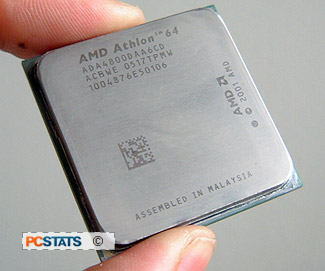 |
| Overclocking Results: |
|
|
Over the years, AMD has allowed enthusiasts a lot of freedom to experiment
with components although things have tightened up slightly with the release of
the Athlon64. Sadly, gone is the full multiplier access in AMD's mainstream
products, complete multiplier control is only available in its super high end
'FX' processors.
Considering the amount of heat the
Athlon64 X2 4800+ produces while under load (110Watts), it's a perfect
opportunity to place it under the freezing Prometeia Mach II GT evaporator.
I wanted to
get the best performance possible, and as the test memory has been
tested up to 270ish running 2-2-2-5 with 3.8V, we kept things
running 1:1.
 Right from the
get-go the Athlon64 X2 4800+ started to have problems at 217 MHz.... weird.
The system just kept BSOD'ing while booting WindowsXP. Increasing the CPU voltage to
1.35V seemed to stabilize that, and we were able to continue onwards with the overclocking. The CPU hit
another snag at 236 MHz, and once more a voltage increase was the necessary solution. This
time the voltage was bumped to 1.4V. At 243 MHz the system had problems
POSTing and, you guessed it CPU voltage solved this problem.
Right from the
get-go the Athlon64 X2 4800+ started to have problems at 217 MHz.... weird.
The system just kept BSOD'ing while booting WindowsXP. Increasing the CPU voltage to
1.35V seemed to stabilize that, and we were able to continue onwards with the overclocking. The CPU hit
another snag at 236 MHz, and once more a voltage increase was the necessary solution. This
time the voltage was bumped to 1.4V. At 243 MHz the system had problems
POSTing and, you guessed it CPU voltage solved this problem.
To reach the 3.0 GHz
mark, the voltage was increased further still to 1.5V. Of course since we were testing
the Athlon64 X2 4800+ with a phase change cooler, the system was able to compensate for
the increased heat output while still maintaining sub-zero temperatures. If you attempt overclocking with a
standard heatsink, we do not recommend increasing the voltage this high. The Athlon64
X2 4800+ produces a heck of a lot of heat.
Never satisfied, we continued to increase the motherboard
clock speeds, and in the end we could run the Athlon64 X2 4800+ at 3.14 GHz
(262 MHz) 100% stable with 1.7V. As you will see shortly, overclocking did boost performance very nicely
in the benchmarks. Be warned though, you had better have a very good cooling solution
before attempting anything like this. Now, on to the benchmarks!
 |
| PCStats Test System Specs: |
|
system 1 |
system 2 |
| processor: |
intel pentium 4 540
intel pentium d 840 |
athlon64 4000+
athlon64 x2 4800+ |
| clock
speed: |
16 x 200 mhz = 3.2 ghz |
12 x 200 mhz = 2.4 ghz
12 x 262 mhz = 3.14
ghz |
| motherboards: |
gigabyte ga-8anxp-d, i925x
gigabyte ga-81955x royal |
dfi lanparty nf4 sli-dr |
| videocard: |
msi rx800xt-vtd |
msi rx800xt-vtd |
| memory: |
2x 512mb crucial ballistix pc5300 |
2x 512mb corsair twinx3200xl pro |
| hard drive:
|
74gb western digital raptor |
74gb western digital raptor |
| cdrom: |
msi x48 cd-rw/dvd-rom |
nec 52x cd-rom |
| powersupply: |
vantec stealth 470w |
vantec stealth 470w |
| heatsink: |
thermaltake jungle 512 |
prometeia mach ii gt (review) |
| Software
Setup |
WindowsXP
WindowsXP 64
Intel INF
7.2.1.1003
Catalyst 5.6 |
WindowsXP
WindowsXP 64
nVIDIA nForce4
6.53
Catalyst 5.6 |
| Benchmarks
|
SYSmark 2004
Business
Winstone 2004
Content Creation 2004
SiSoft Sandra
2005
Cinebench 2003 (32/64 Bit)
Maya Render
Test
ScienceMark 2.0 (32/64 Bit)
Super Pi
1.1
Hexus piFast 4.1
POVray
3.1g
PCMark04
PCMark05
3DMark2001
3DMark05
Comanche
4
UT2003
UT2004
Doom 3
| |
Overclocked tests were run in the 32-bit WindowsXP environment only.
